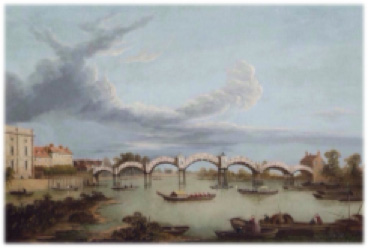Ferries were in operation crossing the Thames prior to the building of the first bridge. They were particularly important because of the increase in river and highway traffic after Henry V111 took over the palace. There is still a pedestrian ferry in operation (March to October) boarded opposite Hamptons oldest church on the north bank and by the Molesey Heritage marker on the south bank.
The First Bridge at Hampton Court was constructed 1752-1753, in the Chinoiserie Willow Chinese style pattern, popular at the time. It was only in use for twenty-five years. The Second Bridge opened in 1778 and consisted of eleven arches and was constructed of wood. However, by 1840 it had become run-down, and was replaced by the Third Bridge which was opened on the 10th of April 1865.
Composed of wrought iron lattice girders resting on four cast iron columns, a commentator of the period called it, ‘One of the ugliest bridges in England and a flagrant eyesore and disfigurement both to the River and to Hampton Court.’ Tolls were charged for using the bridge, which proved lucrative for the owner Thomas Allen, earning him over £3,000 annually until he was brought out in 1876 for £48,048 by a joint committee of the Hampton and Molesey local boards and the Corporation of London. In that year tolls were discontinued and local people celebrated this news by holding a party on the nearby green.
The present bridge was one of three authorised by parliament in 1928 to be built over the Thames. The others being Twickenham and Chiswick. The new Hampton Court Bridge was designed by W P Robinson and the architect was Sir Edwin Lutyens. It was built slightly downstream, and the river was also widened. Construction began in September 1930, and required demolition of the Old Castle Hotel, and diversion of the flow of the River Mole, into the River Ember.
The bridge was made of reinforced concrete, faced with red bricks and white Portland stone. On the 3rd July 1933 it was opened by the Prince of Wales (later King Edward V111). Hampton Court Way, leading to the bridge was built during this period.
Several events are held in the area each summer including the Music Festival, and Flower Show, both within the grounds of the palace. A new event began in August 2011 when the bridge became a river crossing point for the first London Surrey Cycle Classic Race. Followed in 2012 by the cycle road races of the London Summer Olympics.
The annual 100 amateur, and the shorter 46 contest both start at Queen Elizabeth Park, and the riders pass through several London boroughs before crossing Hampton Court Bridge and travelling into Surrey, later returning over the bridge to the Middlesex bank and continuing into the capital, finishing in the Mall. The Classic 150 competition for professional cyclist’s starts at Horse Guards, and after travelling for approximately four hours, also through London and Surrey, the riders will finish in the Mall. All part of the Prudential Ride London-Surrey event, this year the various races are being held on the weekend of Saturday 28th and Sunday 29th July.
“The Thames is Liquid History”
‘a quotation by John Burns.’
By Molesey Matters Reader John Taylor

